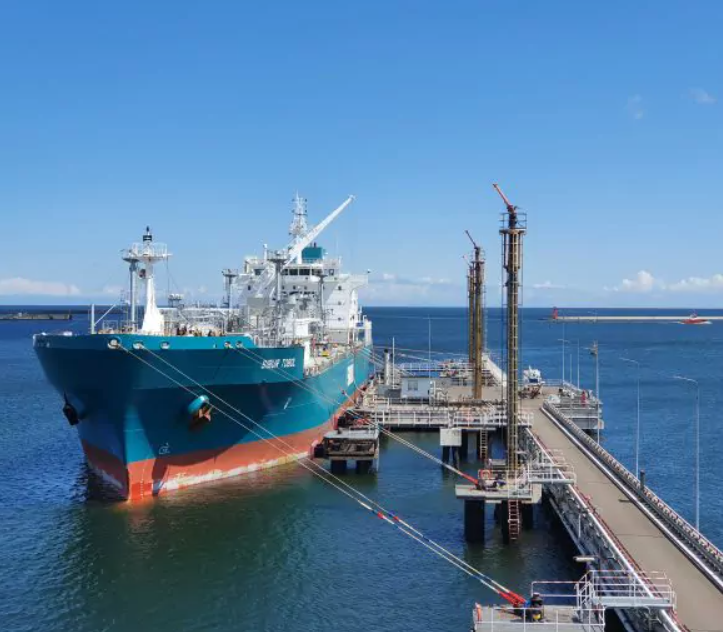Maritime transport is the basis of trade, especially when it comes to large-sized goods. Shipping containers, fuel and armored vehicles must be moved around this way. Gdańsk is Poland’s maritime gateway as the majority of cargo goes through this port. The growing volume of coal and liquid fuels transhipped in Gdańsk reveals its importance for Poland’s energy security – writes Marcin Karwowski, editor at BiznesAlert.pl.
The history of the harbor in Gdańsk dates back to the early Middle Ages, and today it is Poland’s biggest port. The European Statistical Office (Eurostat) has been providing transhipment data on its website since 2013, and the latest data is for 2022. In the case of Poland, five ports were taken into account: Gdańsk, Gdynia, Police, Świnoujście and Szczecin. During that period Gdańsk has remained on top of the list when it comes to the amount of transshipped goods.
Polish number one, EU number five
In 2013, 116,472 thousand tons of cargo passed through Polish ports. The port of Gdańsk accounted for 27,335 thousand tons, Gdynia 15,051 thousand and the third place was taken by Świnoujście with 12,024 thousand tons. Szczecin transshipped 7,886 thousand tons, and the list is closed by the Police with 1,465 thousand tons. In 2022, the Port of Gdańsk handled over 63,153 thousand tons of cargo, more than half of all goods transshipped in Polish ports. The second place went to Gdynia with 23,060 thousand. Interestingly, the results of the ports from year to year grew more or less evenly, with the exception of the pandemic year of 2020 and 2021 when Gdańsk made up for the decline. A significant increase in the volume occurred in 2022, when Russia invaded Ukraine. Gdańsk transhipped more cargo than in the previous year by 18,133 tons. Looking at the entire period 2013-2021, there has never been a year-on-year increase of more than five thousand tons. Thus, it is apparent that after the invasion and the world turning its back on Russian markets, the Gdańsk port started to play a more significant role in international transport.

The volume of cargo transported to / from Polish ports. Source: Eurostat
On top of that, Gdańsk has not stayed behind in the EU. In the first quarter of 2023, it ranked fifth in the EU in terms of goods handled. The port processed 20,465 thousand tons, Amesterdam took the fourth place with 21,572 thousand tons. Rotterdam continues to lead the way in European ports, with 101,928 thousand tonnes closed in the first quarter of 2023. Eurostat has not yet provided data for the rest of 2023.
EU ports by weight of goods handled. Source: Eurostat
Grain, coal and oil
The Port of Gdańsk handles a number of goods and the facility’s webpage provides summaries for the years between 2010 and 2022. The port administration has listed liquid fuels, timber, coal, grain and other bulk commodities such as aggregates, sulphur and ore. Comparing 2021 and 2022, there was a similar amount of transhipped small items and wood (23.4 to 23.5 million tons in 2023), other bulk goods (4.5 million tons to 4.1) and a slight increase in grain from 1.6 to 1.9 million tons. When it comes to grain, it is clear that during the pandemic in 2020 the transhipment almost tripled. At that time, 1.5 million tons were transhipped, while in 2019 – 0.6.
The most interesting change in volume in 2022 can be observed in fuels. As for coal, it has almost doubled compared to 2021. We are talking about a transhipment of 13.2 million tons instead of 4.8. It is worth mentioning that the previous record was in 2018 and it was 7.2 million tons. In the years between, a gradual decline can be observed.
The Port of Gdańsk also handled a record amount of liquid fuels, i.e. oil, petroleum products, diesel and fuel oils and LPG gas. In 2022, 25.5 million tons of liquid fuels were transhipped, compared to 18.9 tons a year earlier. Before that a noticeable decline was in 2020.
The increased transport of fuel through the port of Gdańsk is the result of Russia’s invasion of Ukraine. Mostly, the embargo on Russian goods, including fuel. It is worth remembering that the 12th sanctions package will also ban LPG, of which Poland is an importer. This poses new challenges for Poland’s transhipment infrastructure, but EU member states have a year to prepare for it.
Transshipment chart. Source: Port of Gdańsk
Bunkering and fuel base
On the territory of the Port of Gdańsk there is a liquid fuels depot, where the unloading, loading and transshipment of fuels takes place. The infrastructure includes stations for transshipment of oil and petroleum products. As the port administration assures, security issues have been properly taken care of. Transshipment is carried out in a closed system, the pool is equipped with anti-spill dams and fire-fighting equipment. The facility is as safe as possible for the environment. With the help of the transmission infrastructure, direct transport to the Gdańsk refinery and Germany’s eastern lands is possible. The declared annual transhipment capacity is 40 million tonnes. The depot is owned by Naftoport and operated by Port Północny.
LNG bunkering service is also provided at the port, i.e. filling the vessels’ tanks with liquefied natural gas. The truck to ship method is used for this, where a marine unit is loaded with the help of an tanker truck. In addition, the ship that has arrived at the port can be supplied with electricity to continue its journey.
Coal transshipment is carried out on the coal pier. The export terminal has been completely mechanized. The fossil fuel can be loaded directly from freight cars or from the sites where it is stored. The solutions allow to reload 1,600 tons within an hour. 600,000 tons can be stored in these areas, and within a day the Port of Gdańsk can load 35,000 tons on a ship. As for the import terminal, it was mainly adapted for the transshipment of coal and iron ore. It can load 25,000 tonnes in a day, load freight cars at a rate of 2,000 tonnes per hour and unload 1,600 tonnes per hour. On average the stacking yards can hold 1.5 million tons.
The Port of Gdańsk as a fuel gateway to the world
Port of Gdańsk, mass cargo terminal. Source: Port of Gdańsk
The infrastructure located in Gdańsk allows transhipment not only of shipping containers, but also of coal and liquid fuels. The growing volume shows that Gdańsk is an important part of the energy transition. The move away from Russian raw materials (mainly fuels) has created the need to open up to alternative markets. Gdańsk is the right port to handle this.











